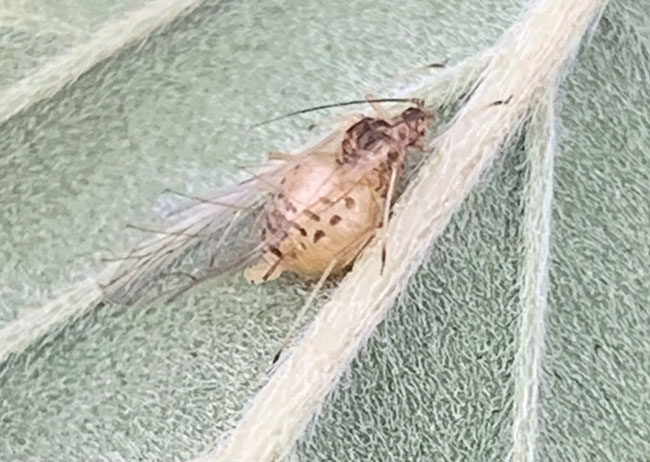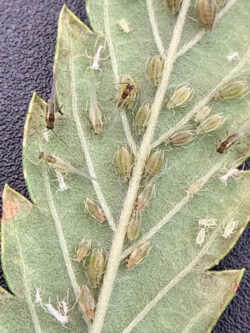
Features
Cannabis aphids on the rise
They are quickly becoming one of the most prevalent pests on cannabis crops
November 18, 2022 By Alia Reeves
 A cannabis aphid mummy.
A cannabis aphid mummy.
Cannabis aphids (Phorodon Cannabis) are quickly becoming one of the most prevalent pests on cannabis crops. Fortunately, their physical and behavioural characteristics allow them to be easily identified and distinguished from other aphid species.
The cannabis aphids’ most defining feature is their antenna tubercules, which appear as horn-like structures at the top of their heads, and can be observed with the use of a microscope. Their colouration can range from yellow-green, green, or pink-brown and may have vertical stripes running down their bodies. Winged morphs are generally brown and green and appear to have harder more chitinized bodies.
Cannabis aphid feeding behaviour is somewhat unusual compared to other foliar aphids. Many other foliar aphids generally have a preference for feeding on leaves and select stems as a food source once their population reaches a certain threshold. Cannabis aphids, however, seem to have as much of a preference for feeding on stems as they do leaves. In areas of low infestation, they have been observed feeding on stems just as often, if not more so, as on leaves.
Life cycle
Aphids are able to reproduce sexually and asexually. Sexual reproduction occurs during the fall in preparation for overwintering; aphids overwinter as eggs that require a cold snap before that are able to hatch the following spring. In warmer climates and greenhouses where temperatures remain well above freezing, aphids reproduce asexually by parthenogenesis. In this case, aphids give birth to living and already pregnant female offspring. It is estimated that cannabis aphids birth one to five aphids daily during their three- to four-week lifespan.
Crop damage
Cannabis aphids are sap-sucking insects that not only cause feeding damage that weaken plant health, but also transmit viruses and contaminate products through their honeydew excretion. As aphids feed on plant sap, they secrete a honeydew that falls from the feeding aphids on the underside of leaves to the top surfaces of the leaves below. This causes the top sides of the leaves or flowers to become sticky. Brown sooty mold is attracted to this honeydew and as it feeds and grows, it inhibits photosynthesis and causes contamination. Exoskeletons shed by the aphids also stick to the honeydew, which can further contaminate flowers.
Pest management
Preventative and mechanical:
Crops should be scouted and monitored regularly with clear documentation of pest pressures. Plants should be examined by flipping leaves to detect early infestations. Sticky cards should be hung near the plants – but avoid touching – and monitored. Winged aphids looking to establish within the crop, or looking to disperse from an already established hotspot, can be found on cards and indicate corrective action will need to take place. Corrective action can include removing infested leaves, releasing beneficials or applying pesticides. Keeping accurate records will help determine if control methods were successful.
Releasing beneficials preventatively can aid in ‘scouting’ as they hunt for prey. However, specialized aphid predators will have to be replaced weekly or bi-weekly as they may starve due to a lack of food. Depending on the predator and/or release rate, they may only provide suppression by slowing the population growth.
Maintaining a crop pruning schedule can remove any colonies that have not yet been discovered. However, it is only effective if plant material is removed from the facility, otherwise, it may act as a re-entry point. Scheduled pruning and de-leafing will also allow for better spray coverage and air flow. It also aids scouting as it is more effective to be able to see through plants rather than just the exterior leaves.
Maintaining a strong biosecurity program should be part of any IPM program. Personnel should arrive with clean or facility-specific clothing. New biomass should be quarantined and monitored prior to introducing to the rest of the crop. This will help prevent the introduction of any new pest.
Biologicals

Cannabis aphids are sap-sucking insects that not only cause feeding damage that weaken plant health, but also transmit viruses and contaminate products through their honeydew excretion.
Anystis baccarum
Anystis baccarum is a large generalist predatory mite that targets aphids, spider mites, thrips, and whiteflies. They hunt indiscriminately by crawling in a circular pattern until they come into contact with a prey item. They can reproduce asexually through parthenogenesis which has significant implications for rapid population growth if provided with enough prey items. To take advantage of this reproductive strategy, A. baccarum are better suited towards longer lived crops, such as greenhouse vegetables or field cannabis, rather than greenhouse cannabis crops that are harvested after approximately eight to 10 weeks. As a predator specifically for cannabis aphids, they are capable of consuming all aphid developmental stages, including winged forms, but are more successful at catching first and second instars; larger aphids often required multiple attempts. They move quickly and are able to travel long distances. This attribute makes them better suited for prevention as they tend to leave hotspots even when infestations remain high. Their potential as an intraguild predator has not yet been fully explored, but due to its indiscriminate nature, any predator it comes into contact with that is smaller than the mite will likely become prey. Unfortunately, they are currently sold at a relatively high price point and do not appear to fill a niche that other aphid predators are incapable of.
Aphidius spp.
Aphidius spp. are parasitoids, or parasitic wasps, that inject their eggs into pest hosts. A single egg is laid into individual aphids where the egg hatches, the larva consumes and develop the host from within, and finally pupates and emerges turning the aphid into a mummy. After the larva pupates within the host, the adult wasp emerges and leaves an exit hole in the aphid mummy. The colour and texture of the mummy depends on the parasitoid species and can range from brown, pink, shiny, or fuzzy. They can be released preventatively to seek out aphid hotspots and slow down population growth. Aphidius matricariae and A. colemani currently appear to be the most successful species at parasitizing cannabis aphids. However, A. matricariae tend to leave greenhouse crops during the warmer months in search of more favourable environments while A. colemani tend to remain as long as there are appropriately sized aphids to parasitize. If released in large enough quantities at the right time, they may be able to control cannabis aphids or, at the very least, provide significant suppression. A. matricariae and A. colemani pair well with most other aphid predators. In the absence of prey, they will need to be released weekly or biweekly as they cannot continue to survive without a food source.
Aphidoletes aphidimyza
Aphidoletes aphidimyza are gall midges with predatory larvae that can consume up to 100 aphids in a week. Unfortunately, larvae undergo diapause and I found them to be unable to establish on vegging or flowering plants. It is not recommended to use this species as a control for cannabis aphids.
Hoverflies
Hoverfly adults are pollinators, that mimic the colouration of bees and wasps, and their larvae are predatory. Some species are migratory, arriving in Canada around April and leaving in September/October. From my experience, their larvae are voracious and may be able to provide control of cannabis aphids. However, during times of high cannabis aphid infestation, hoverflies have been observed to pupate on flowers which can reduce product quality. This may happen without directly releasing them into the facility as they can be attracted from the wild and enter through greenhouse vents or establish themselves in field crops. If hoverflies are to be released, do so during low severity cannabis aphid infestations on vegging plants. They may be able to provide control and move on before the plants flower. While hoverflies are efficient predators, their benefit should be weighed against their potential risk.
Lacewings
There are two types of lacewings available in Canada: brown lacewings (Micromus variegatus) and green lacewings (Chrysoperla carnea). Brown lacewings are predatory as adults and larvae; however, there are not sold by many suppliers and they are often sold in small quantities making them expensive. Green lacewings are predacious as larvae and are commonly available. While the recommended curative release rates were used at both low and high cannabis aphid infestations, green lacewings were unable to provide control. However, they likely slowed cannabis aphid population growth. Exceeding the recommended high curative rate and releasing lacewings while aphid pressure is low could result in control, however, determining such rate and timing is challenging.
Ladybird beetles
Both ladybird beetle adults and larvae are predatory, and the most commonly sold species is Adalia bipunctata. Many species are migratory and arrive in North America around May and leave around August/September. If released into the facility outside of these months, they are likely to leave through greenhouse vents. They may be a risk for product contamination as they may pupate on flowers. Ladybird beetles are effective aphid predators, however, my experience with wild ladybird beetles in a field crop was that they were able to provide suppression.
Scymnus spp.
Scymnus spp. is a type of ladybird beetle that is native to North America and overwinters rather than migrates. They can be attracted into the facility and sustained with the use of banker plants and forgo overwintering. Both the adult and larva are predatory and were observed to gain control of cannabis aphids in a closed system. The larvae show a preference for pupating on solid structures such as the underside of pot lips rather than the plants themselves. They do not appear widely available for sale, but I recommend attempting to attract and sustain them with banker plants if you have the resources to do so. During my breeding program, they were found frequently throughout the facility hunting cannabis aphids.
Chemical
Of the currently registered pesticides for cannabis, insecticidal soap was observed to be the most efficacious in controlling cannabis aphids. Insecticidal soap is a contact spray, so it is important to ensure adequate spray coverage. This can be achieved by maintaining an effective pruning/crop schedule and using appropriate spray equipment. A vertical boom with numerous nozzles pointed upwards at a 45-degree angle to target stems and the undersides of leaves should provide the best coverage.
Print this page